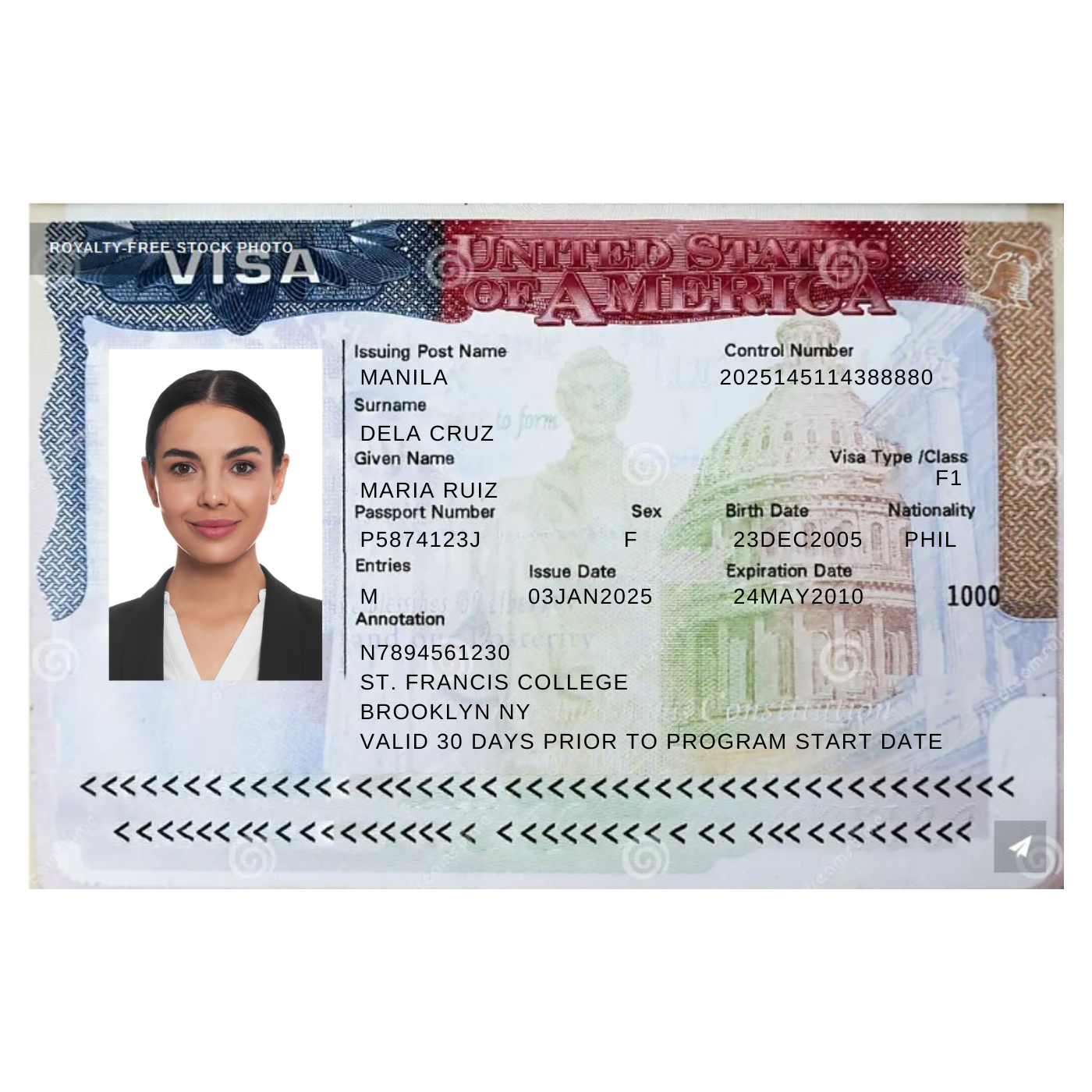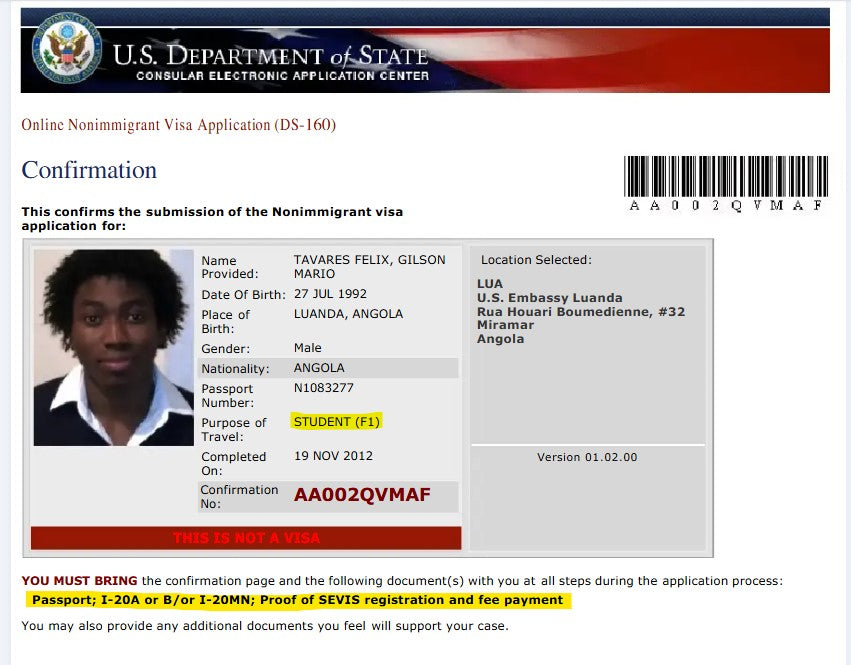
Applying for a F-1 Visa
IIf you are outside the U.S. and do not have a valid F-1 visa, follow the steps below to apply for your student visa at a U.S. Embassy/Consulate in your home country. A visa is an entry document that you must apply for at a consulate outside the United States. You need a valid unexpired student visa to enter the United States. here are some helpful resources to assist you throughout the process.
ON THIS PAGE
A nonimmigrant U.S. visa is an entry document for individuals coming to the U.S. temporarily for specific purposes such as study or work. It is issued by the U.S. Department of State and is attached to your passport.
Where to get a visa
You must obtain a U.S. visa at a U.S. Embassy or Consulate outside of the U.S. To find the consulate or embassy nearest to you, visit the U.S. Consulates and Embassies Abroad website.
See US Embassy in the Philippines for specific information if you plan to apply for your student visa at the US Embassy in Manila.
It is advisable to apply for your visa at a U.S. Embassy in your home country, unless circumstances or travel plans make this impossible. Applying for a visa at an embassy in a country other than your home country is called a “third country national (TCN)” application. Not all embassies accept TCN applications, and some allow TCN applications for limited situations. Be sure to check with individual embassies, including those in Canada and Mexico, for TCN application policies.
It can be risky to apply in a country other than your home country. For instance, if you apply for a new visa in Canada and encounter delays, you must remain in Canada for the length of the processing. You will not be able to reenter the U.S. until the new visa is approved.
When to apply for a visa
U.S. Embassies require in-person interviews for most first-time visa applicants. You are encouraged to schedule the visa interview appointment as early as possible.
See Visa Appointment Wait Times to check the estimated wait time for a nonimmigrant visa interview appointment. Visa processing times vary widely depending on the country, time of year, and if you are required to undergo a background check. If you are subject to a background check, this rigid and time-consuming process will slow down the process. Schedule your visa appointment as soon as you receive your I-20 , but not sooner. Learn more about visa delays.
The earliest you can apply for an F-1 visa is now 365 days (previously 120 days) before the program start date on your I-20, but you may enter the US up to 30 days prior to the program start date.
General Information
The U.S. Department of State website lists the forms, documents, etc. which are required for the U.S. visa application. It is important that you bring everything to your visa interview to avoid needless delays in the processing of your application.
Visit the Department of State website
For general information on F and J visas, visit the U.S. Department of State website.
A visa alone does not guarantee entry into the U.S. You must also carry your other documents, including a valid passport and a valid I-20, DS-2019 or I-797 Approval Notice.

F-1 Student Visa
For general information on F visas, visit the U.S. Department of State website.
F-1 Student Visa Application Process
STEP 1: Pay the SEVIS Fee
Newly admitted students must pay a one-time SEVIS I-901 Fee of $350. Go to the SEVIS I-901 Fee webpage to make your payment. Click on "PAY I-901 FEE" at the top of the page. You will need to provide your SEVIS ID number. The SEVIS ID is a 9-digit number beginning with “N,” found in the upper right-hand corner of the Form I-20.
The SEVIS fee is not a school fee, and it is in addition to any fees you might be required to pay at a U.S. consulate. Dependent family members are not required to pay the fee.
For your interview, you must present the receipt as proof of payment when you apply for visa. It’s important that the SEVIS ID number on your I-901 SEVIS Fee receipt matches your SEVIS ID number on your Form I-20.
If you have paid the I-901 fee, but choose to defer your enrollment, please note that the SEVIS fee can only be transferred for ONE CALENDAR YEAR. If you defer your I-20 for more than a year, you will have to pay the fee again.
STEP 2: Complete the "DS-160, Online Nonimmigrant Visa Application"
To schedule your appointment, first complete the "DS-160, Online Nonimmigrant Visa Application" on the Department of State's website here. When you upload your photo, be sure it conforms to the Photograph Requirements.
Review frequently asked questions about the DS-160. Answer truthfully to the best of your knowledge. Contact your local embassy or consulate with any questions.
For your interview, you are required to bring your confirmation page with your application ID number on it so the visa officer can retrieve your DS-160. You must bring the confirmation page with you during all phases of the application process. Without the confirmation page, they may not be able to process your visa case.
STEP 3: Pay the nonrefundable Visa Application (MRV) Fee
As part of your application, you will be asked to pay the nonrefundable Visa Application (MRV) fee.
The visa application fee for a student visa is $185.
Visa applicants seeking a US Embassy Manila appointment, visit Bank and Payment Options on how to pay for the visa application fee.
STEP 4: Schedule your visa appointment
To find the consulate or embassy nearest to you, visit the U.S. Consulates and Embassies Abroad website. Many consulates and embassies offer online appointment scheduling.
See Visa Appointment Wait Times to check the estimated wait time for a nonimmigrant visa interview appointment. Visa processing times vary widely depending on the country, time of year, and if you are required to undergo a background check. If you are subject to a background check, this rigid and time-consuming process will slow down the process. Schedule your visa appointment as soon as you receive your I-20 , but not sooner. Learn more about visa delays.
See US Embassy in the Philippines for specific information if you plan to apply for your student visa at the US Embassy in Manila.
In most cases, each visa applicant, including children, is required to pay a non-refundable, non-transferable Consular application fee, whether a visa is issued or not. The visa application fee for a student visa is $185.
Visa applicants seeking a US Embassy Manila appointment will log-in to the online appointment system and create a profile. Applicants for U.S. visas are required to appear in person for a biometrics appointment at the Visa Application Center (VAC) AND the visa interview at the U.S. Embassy or Consulate.
See Schedule your Appointment on how to schedule both appointments.
See Bank and Payment Options on how to pay for the visa application fee.
The earliest you can apply for an F-1 visa is now 365 days (previously 120 days) before the program start date on your I-20, but you may enter the US up to 30 days prior to the program start date.
STEP 5: Prepare documents for your visa appointment
The following items are required in support of your application for an F-1 visa:
- Non-Immigrant visa application DS-160 confirmation page
- Valid Form I-20 from the school
- Valid passport (valid for at least six months beyond the date of travel to the U.S.)
- SEVIS I-901 fee payment receipt. Go to the I-901 fee website to pay your fee and print a receipt.
- Current and original financial documentation (issued within the previous 3 months)
- One photograph which meets the Photograph Requirements.
- Other requirements as determined by your U.S. Embassy.
Please note that students admitted to multiple schools must decide which school to attend before applying for a visa stamp.
STEP 6: Attend your visa interview
Review 10 points to remember when applying for a non-immigrant visa from NAFSA: Association of International Educators, the leading organization committed to international education and exchange.
The main purpose of the visa interview is to determine whether you are qualified to study in the U.S. and if you will abide by the terms of the student visa. The consular officer will ask general questions regarding your intended studies or program, your financial arrangements and how you plan to support yourself during your time in the U.S., and your future immigration plans. The F-1 visa is a non-immigrant visas, so you must demonstrate to the consular officer that you plan to return home after your studies. This can be demonstrated through evidence of strong ties to your home country such as family ties, job offers upon graduation, property ownership, or other significant connections that would encourage your return home.
STEP 7: Receive and Review your Entry Visa
Check the visa in your passport to make sure that all the information on it is correct. Your I-20 should be returned to you. You will need it toenter the U.S.
A FEW ADDITIONAL NOTES:
Requesting an expedited visa appointment...
U.S. Consulates may be able to expedite your interview date to facilitate your arrival at the beginning of the academic term and for international student orientation. The process to request an expedited nonimmigrant visa interview varies by location. You should refer to the instructions on the website of the Embassy or Consulate Visa Section where you will interview, or on their online appointment scheduling site. Please note:
- First you must submit the online nonimmigrant visa application form (DS-160), pay the visa application processing fee, and schedule the first available interview appointment, even if that interview appointment is far into the future. Only at this point will a consular section consider your request for an expedited appointment.
- Students and exchange visitors requesting expedited appointments should be prepared to provide an I-20 form showing that they would miss the beginning of their courses/programs if not granted an expedited appointment.
- How to Request an Expedited Interview at the US Embassy in Manila provides additional information and guidance.
Frequently Asked Questions on Completing the DS-160
How do I find the School Code (for F-1)?
For F-1 Students, the school code can be found under the School Information section on page 1 of the I-20. The section is titled “School Code and Approval Date.”
Who should I put as the U.S. point of contact on the DS-160?
Use your DSO's name (as listed in your I-20), your school's address and contact number.
What should I put as my intended field of study? The major as it is written on my I-20, or the major as it’s written in my decision letter?
It is best to list your major as it is written on your I-20, as that is your official university and government document.
What should I put for my intended length of stay in the U.S.? The length of my program (e.g. 1 year) or the length of my I-20 (e.g. 3 years)?
The information you enter on the DS-160 should match what is on your I-20.
I don’t have an apartment yet. What should I put for my U.S. address?
If you have identified the place you would like to live, or have applied for housing, you may enter that address on the DS-160, even if the housing is not confirmed yet. If you have not started researching housing yet, you may enter the school address listed on your I-20.
I have heard that I am required to provide social media usernames on my visa application. Is this true?
Yes, this represents a newer series of questions on the Form DS-160. Visa applicants must provide information regarding any social media platforms that they have used during the five years preceding their visa application. You are required to provide any usernames or handles used on those platforms including Facebook, Instagram, LinkedIn, Reddit, Twitter, Weibo, YouTube, and more. You can make selections from a pulldown menu.
On Present Work/ Education/ Training Information
Select the best option that is true at the time of submitting the application.
On Person/ Entity Paying for Your Trip
List your primary source of funding as it appears on your I-20

DS 160 Confirmation Page
For your interview, you are required to bring your confirmation page with your application ID number on it so the visa officer can retrieve your DS-160. You must bring the confirmation page with you during all phases of the application process. Without the confirmation page, they may not be able to process your visa case.
Visas for spouse and children...
The spouse and unmarried children (under the age of 21) of F-1 students may either accompany the student to the United States or come at later date by entering the U.S. on an F-2 visa. In order to apply for an F-2 or J-2 visa, the dependent(s) will also need a I-20 or DS-2019.
F-2 visa restrictions
Study: F-2 spouses may study part-time. This means an F-2 spouse can begin a part-time academic program at any educational institution. F-2 children may study full-time in K-12 schools (elementary, middle/junior high and high school).
Employment: F-2 dependents may not accept employment or engage in business under any circumstance
If you experience a visa delay....
Processing times and delays vary by U.S. Consulate/Embassy. A vast majority of visas are issued within days of a visa interview/appointment. Anyone applying for a visa may be subjected to an administrative processing delay or a background check that may take several weeks. Please look at the information on the Department of State website for more information on visa processing and visa delays.
